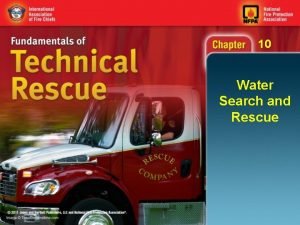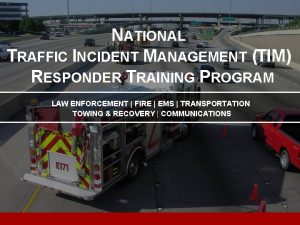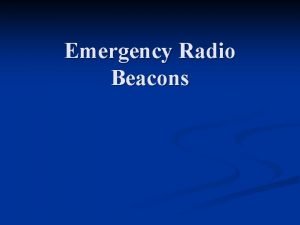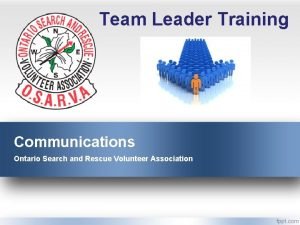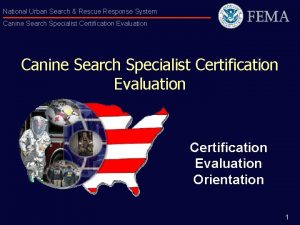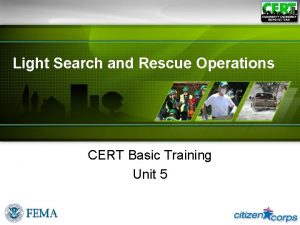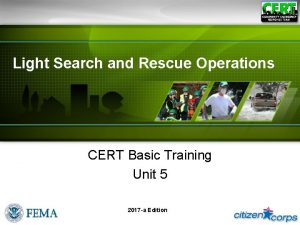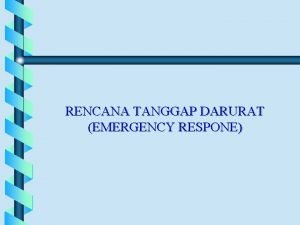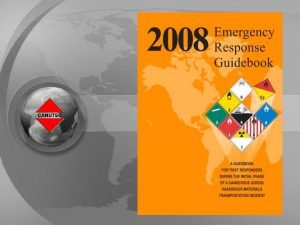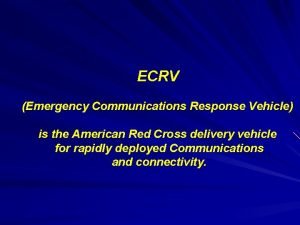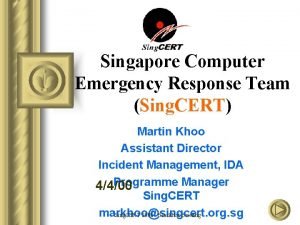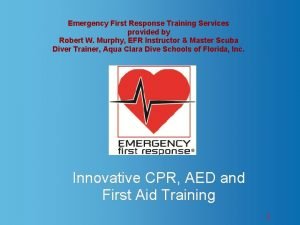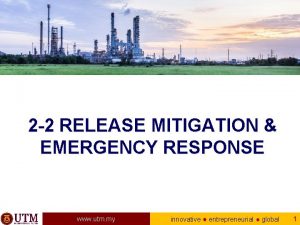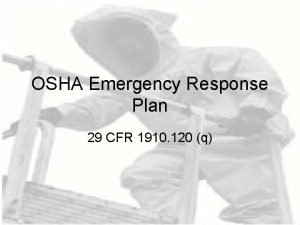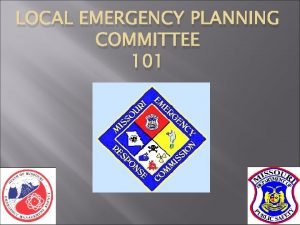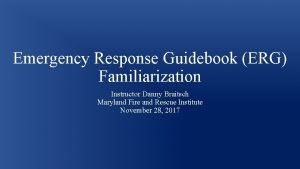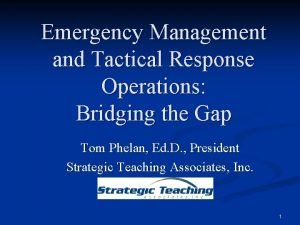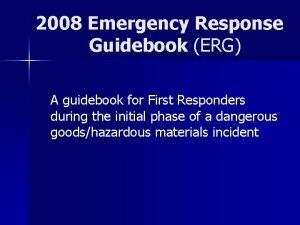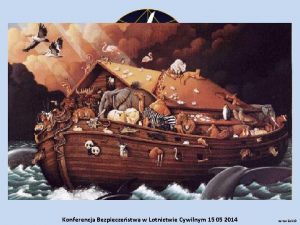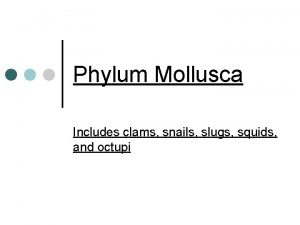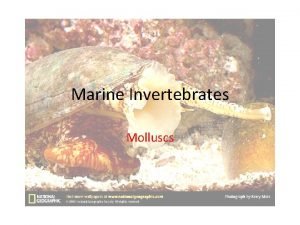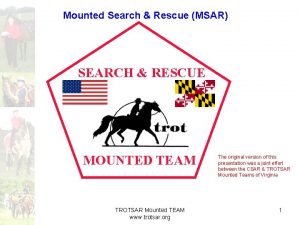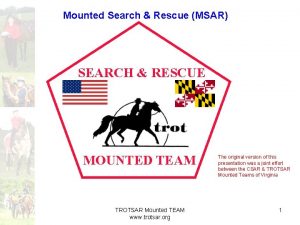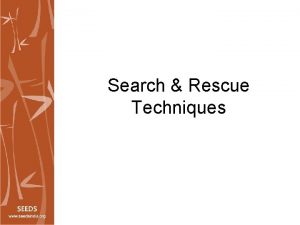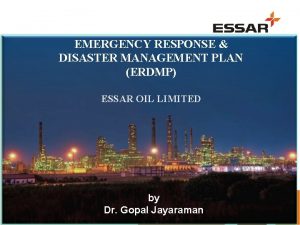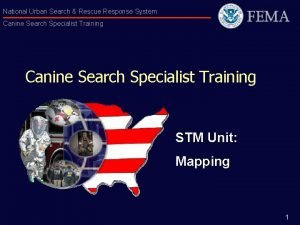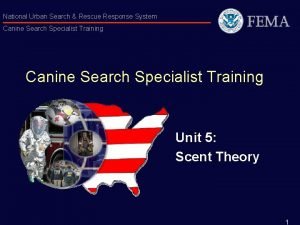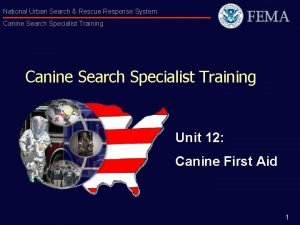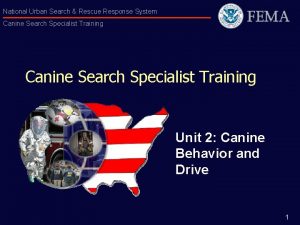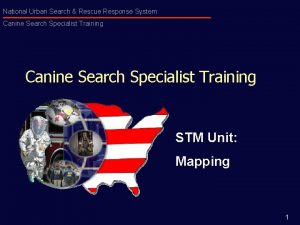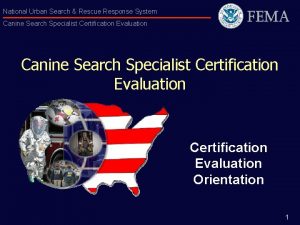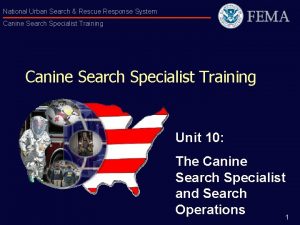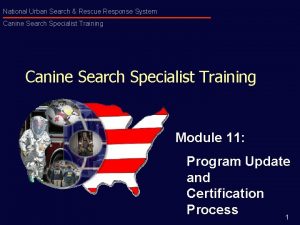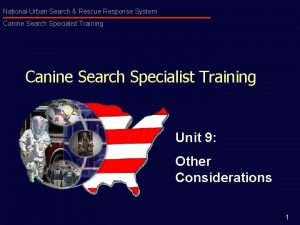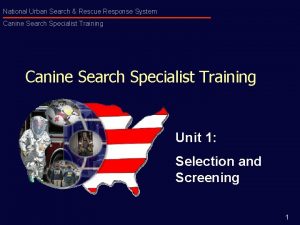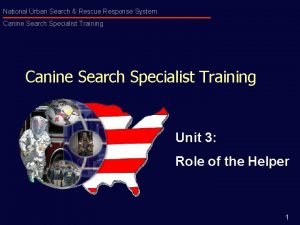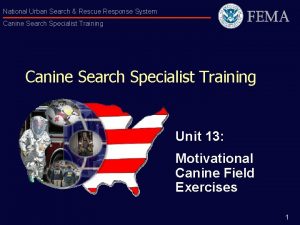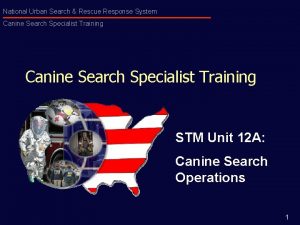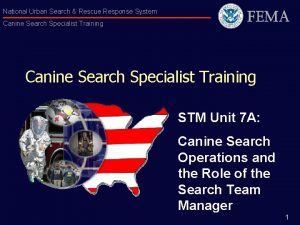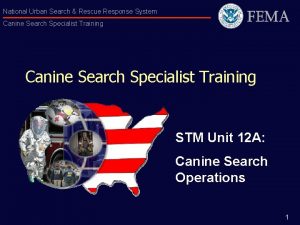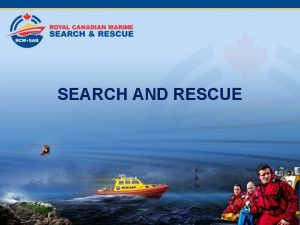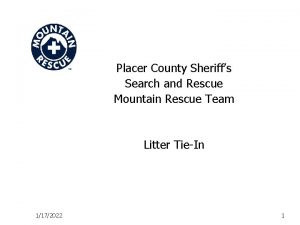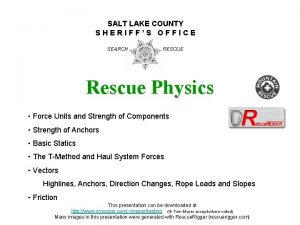Understanding Emergency Response Management including Search and Rescue










































- Slides: 42

Understanding Emergency Response Management, including Search and Rescue and First Aid National Disaster Management Practitioners, Islamabad, Pakistan Module 3 Session 3. 1

Learning Objectives At the end of the session, participants will be able to: • Define the different concepts in emergency response • Understand the different phases and key elements needed for emergency response management including local level Search and Rescue and First Aid activities

Basic concepts of Emergency Response Management (ERM) What is an Emergency? An event, actual or imminent, which endangers or threatens to endanger life, property or the environment, and which requires a significant and coordinated response.

What is Response? “Response is a reaction to such a situation or event”. • Response can from an individual to national level • The response phase of an emergency may commence with search and rescue but in all cases the focus will quickly turn to fulfilling the basic life saving and humanitarian needs of the affected population

Characteristics of Emergency Disruptive to individuals and communities Not part of day-to- day experience Unpredictable in occurrence and effects Requires a response Local resources may be inadequate Wide range of destructive effects and impacts on the humans, animal and/or plant life, health, property and/or the environment • Complex needs in dealing with them • Can be of sudden onset • Overwhelm normal prudent protective measures • • •

Aim of the Emergency Response Management “To reduce mortality rate and damage to property thereby reducing the impacts of disaster and to ensure successful recovery of maximum number of people”

Importance of a Timely & Coordinated Response Depending on injuries sustained by the victim, outside temperature, and victim’s access to air and water, the vast majority of those affected by a disaster will die within 72 hours after impact

Activities included in ERM • Search & Rescue • Fire Fighting • Emergency Medical Assistance including first aid, mass casualty management and physiological first aid etc • Transportation of victims • Need Assessment Survey • Hospital Preparedness • Evacuation • Provision of food and non-food items • Temporary shelter • Emergency repair of critical facilities • Security measures/tracing/family reunification

ERM consist of a range of activities, which took place for managing the risks eminent to the communities and the environment. These measures are; Plans System & Policies Administrative decisions Operational activities which pertain to the various stages of an emergency at all levels • Resource availability • •

Preparedness for Effective Response Common preparedness measures include: • Communication plans • Proper maintenance and training of emergency services, such as community emergency response teams • Development and exercise of emergency population warning methods • Emergency shelters and evacuation plans • Stockpiling, inventory, and maintain disaster supplies and equipment

Principles of Emergency Response Management • Comprehensive-risk assessment • Action plan for prevention, preparedness, response and recovery • All hazards- managing the large range of possible effects of risks and emergencies • All agencies & integrated • Appropriate resourcing

Local Level Search and Rescue Techniques Search and rescue functions are divided into two aspects: a. Search: to carefully look for victims in order to find someone missing or lost b. Rescue: to free a trapped victim/casualty from confinement or from under a rubble

Components of Search & Rescue operation 1. Rescuers: includes trained personnel and volunteers 2. Tools: depend on their availability and the needs of the situation 3. Time: may be very limited for some victims. The first 24 hours after a disaster are called the “Golden hours” where injured or trapped victims has an 80 percent chance of survival, if rescued

Principles of the Search and Rescue • • Search and Locate Victim Gain Access to the Victim Stabilize the Victim Extricate the Victim

Four steps for rescuer’s safety • Survey the scene (i. e. prevent further injuries by identifying potential environmental or other risks to the rescuer, victim or by standers) • Determine first aid needs • Plan your course of action • Build the rescue system

Principles for search and rescue operation • How to approach the damaged buildings • Dos & Don’ts • Damaged buildings and facilities should only be approached from the least dangerous side • While surveying indoor space in buildings, do not use open fire (torches, kerosene lamps) for lighting

• When searching for casualties DO NOT walk or stay near badly damaged and collapse-prone buildings • Do not allow many people to gather in one spot, in shafts, or floors • Do not go near collapse-prone walls or other constructions • Move very carefully over building ruins (only if it is absolutely necessary) as they are unstable heaps of fragments

• When removing rubble from ruins, do not permit abrupt jerks, shaking, or strong blows at the site • When clearing ruins, first drag away and extinguish any smoldering or burning objects • Open doors to burning rooms very cautiously, be aware of possible flame or hot gas ejection • In burning spaces, move by bending low or else on your knees. Try to stay near windows, making it possible to get quickly out of the danger zone if need be

• If an electrical cable is discovered, suspend it, in order to avoid further damage or tearing; Do not step on wires • Double-check the system • Initiate your plan (i. e. administer first aid, self rescue and/or locate assistance)

Basic Rescue Evacuation Techniques Evacuation & Rescue by applying simple manual techniques can save the life of the victim Few important rescuing techniques are; 1. One rescuers • • Ankle pull Shoulder pull One-person lift Pack-strap carry

2. Two rescuers • • • Human crutch / two-person Drag Four-handed seat Two-handed seat Chair carry Improvised stretcher Blanket stretcher Hammock carry

Ankle pull The ankle pull is the fastest method for moving a victim a short distance over a smooth surface. This is not a preferred method of patient movement.

Shoulder pull The shoulder pull is preferred to the ankle pull. It supports the head of the victim. The negative is that it requires the rescuer to bend over at the waist while pulling.

One-person lift This only works with a child or a very light Person.

Pack-strap carry When injuries make the rescuer Carry unsafe, this method is better for longer distances than the one-person lift

Human crutch / two-person drag For the conscious victim, this carry allows the victim to swing their leg using the rescuers as a pair of crutches. For the unconscious victim, it is a quick and easy way to move a victim out of immediate danger

Four-handed seat This technique is for carrying conscious and alert victim’s moderate distances. The victim must be able to stand unsupported and hold themselves upright during transport.

Improvised Stretcher This technique requires two poles/pipes strong enough to support the victim's weight and at least two shirts

Basic Medical First Aid Techniques First Aid is the initial immediate assistance or treatment given to someone who is injured or has suddenly fallen ill before the arrival of an ambulance, doctor or other appropriately qualified person.

First Aid Priorities • • • Assess the situation quickly and calmly Protect yourself and casualties from danger Assess the conditions of all casualties Comfort and reassure the casualties Deal with any life threatening conditions first Obtain medical aid if necessary

Whom to approach first? There are three conditions that immediately threaten life: • Breathing problems • Heart problems • Serious Bleeding When there is more than one injured person, go to the quiet one first. They may be unconscious and need attention.

Action at an Emergency (DRABC) D: Danger: Assess the situation: are there any dangers to yourself or the injured person? If it is there, either remove the danger or take the casualty out of danger

R: Response Assess the person for responsiveness: do they respond to your voice and being gently shaken?

A: Airway Check and open the airway; Place one hand on the forehead, tilt the head back and lift the chin

B: Breathing Look, Listen and Feel for breathing • Look for chest movement, listen for sounds of breathing and feel for breath on your cheek. • Do this for no more than ten seconds. • If the person is breathing normally, assess for life threatening injuries and then place in the recovery position and maintain an open airway

C: Compressions • If they are NOT Breathing normally, send a helper to call an ambulance and start Cardiopulmonary resuscitation (CPR) • Cycles of 30 chest compression followed by 2 rescue breaths or • only continue chest compression at the rate of 100 compression per minute

C: Circulation Look for blood pumping or pouring out of a wound, control it with direct pressure, look for normal tissue color

Recovery Position If an adult or child is unconscious but breathing normally, place them on their side in the Recovery Position. 1. Place arm nearest you at a right angle with palm facing up

2. Move other arm, palm upwards against the person’s cheek. Then get hold of knee furthest from you and pull up until foot is flat on the floor 3. Pull the knee towards you, keeping the person’s hand pressed against their cheek and position the leg at a right angle

Bleeding • Applying direct pressure to external wounds by using sterile cloth or gloved hands to control bleeding • Blood loss can be serious and should be treated as quickly as possible • Raise the wounded part above the level of the heart

• Your main aim is to stem the flow of blood • If you have disposable gloves, use them if not then wear any plastic bag • Check whethere is an object embedded in the Wound if there is nothing embedded, press on the wound with your hand, ideally over a clean pad and secure with bandage

Burns and Scalds • Burns and scalds are the most common injuries requiring emergency treatment • Cool the burn area as quickly as possible by placing the affected area under cold running water for at least 10 minutes • Cover the injury using a clean pad or cling film and seek medical advice • Call for help in severe cases
 Objectives of search and rescue team
Objectives of search and rescue team The mutcd states all workers
The mutcd states all workers Search and rescue radar transponder
Search and rescue radar transponder Beacon
Beacon Ontario search and rescue volunteer association
Ontario search and rescue volunteer association Urban search and rescue markings
Urban search and rescue markings Leveraging and cribbing
Leveraging and cribbing Image search
Image search Pierce county search and rescue
Pierce county search and rescue Contoh rencana tanggap darurat
Contoh rencana tanggap darurat What is the green section of the erg
What is the green section of the erg Ercp emergency response
Ercp emergency response Ecrv
Ecrv Sing cert
Sing cert Emergency response training services
Emergency response training services Utm emergency response plan
Utm emergency response plan Emergency response plan osha
Emergency response plan osha Missouri emergency response commission
Missouri emergency response commission Yellow section of erg
Yellow section of erg Emergency disaster tactical response
Emergency disaster tactical response Erg 2008
Erg 2008 Walmart emergency management
Walmart emergency management Erp emergency response plan
Erp emergency response plan Emergency response tool
Emergency response tool Natural and forced response
Natural and forced response Natural response and forced response example
Natural response and forced response example Primary immune response and secondary immune response
Primary immune response and secondary immune response Informed search and uninformed search in ai
Informed search and uninformed search in ai Invertebrates including snails slugs and mussels
Invertebrates including snails slugs and mussels Invertebrates including snails slugs and mussels
Invertebrates including snails slugs and mussels Comparison of uninformed search strategies
Comparison of uninformed search strategies Federated search vs discovery
Federated search vs discovery Local search vs global search
Local search vs global search Federated search vs distributed search
Federated search vs distributed search Https://images.search.yahoo.com
Https://images.search.yahoo.com Best first search is a type of informed search which uses
Best first search is a type of informed search which uses Blind search dan heuristic search
Blind search dan heuristic search Gravity yahoo
Gravity yahoo Video.search.yahoo.com search video
Video.search.yahoo.com search video Pros and cons of binary search
Pros and cons of binary search Linear search vs binary search
Linear search vs binary search Tw yahoo news
Tw yahoo news Multilingual semantical markup
Multilingual semantical markup
